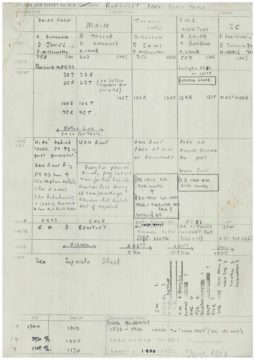The photo shows a radio links van at a mid-point on an outside broadcast at the Burghley Horse Trials, in September 1985. The radio links van would receive the OB signal from the truck at the event, and then send it on to the transmitter, or to another links van.
The following comments were posted on the Pebble Mill Facebook page:
Bryan Comley: ‘Burghley is a huge job with 20 plus cameras covering the cross country course, today the cameras all come back to one truck via fibre optics. In the 80’s there were two trucks one at the start/finish and one at Lion bridge, the cameras at the extremes of the course were radio linked to the trucks , Formula one at Silverstone use cross course microwave too.
Too get the pictures on air, links had to be set up to the nearest inject point, either a BBC centre or a transmitter site, the max distances for one link was around 40 miles sure to the curvatures of the earth and signal strength, so mid points on high ground would be set for some OBs. This could fail due to fog if the midpoint was high above the fog and the OB was in fog as the beam would get bent leaving the fog.’
Steve Dellow: ‘Indeed – a big job – and I’ve still got the Comms planning sheets! In 1985, at Burghley Park there were two Comms vans (758 and 602) – ‘Dairy Park’ and Main. The van in the photo (356) was at Tinwell Lodge (with Generator PG50), then 587 at Cold Overton, then onwards to Sutton (and underground circuit to Pebble Mill). Receiver 102R and Transmitter 124T on the top of 356, with Pete Myslowski asleep in the cab! I was supposed to give £25 cash to the site owner (Mr Flint), plus £20 as they hadn’t been paid the year before! The ‘hops’ were 5km, 18.5km, and 69km.’
Malcolm Hickman: ‘On other occasions, we used a different mid point, where the vehicle would pick up the signals (7ghz microwave) and relay them to a receiver located at the Morborne transmitter. We used a passive reflector up the mast to bounce the signals down to a receiver on the ground. They were then injected by BT into a protection circuit to Pebble Mill.’
Roy Thompson: ‘As explained radio links had to be line of sight. This could be a problem for some starter links (the first one from the ob site) especially in town centres. Eagle towers were used, which had a self erecting, two stage tower which would carry the transmitter. It was rigged at 30 foot and then sent up to its maximum height of 60 foot. Have no actual photos but came across this model Dinky toy at my local dentist. Unfortunately the second part of the tower is missing.’

Andy Marriott: ‘I love seeing stuff like this. I joined the comms dept at Pebble Mill in 2000. But by then it was a shadow of its former self. Still got to work on a few OB’s before the plug finally got pulled a year or so later. OB’s aren’t nearly as cool when they’re over satellite or fibre!’

